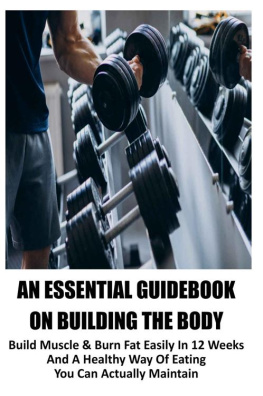Introduction
Chapter 1: Tools We Will Be Using For Progress Tracking
Chapter 2: Training or Nutrition: Which one is more important?
Chapter 3: Fundamentals
Chapter 4: Macronutrients
Chapter 5: Setting Up Your Macronutrients
Chapter 6: Boost Your Gains With Pre And Post Workout Meals
Chapter 7: Meal Planning
From Here Is Up To You
Introduction
Who this book is for?
If you know nothing about nutrition and the science behind building muscle then this book is for you! . The purpose is to write a concise guide that helps you to achieve your particular goal, whether is gaining muscle, losing fat or both.
I have read almost every best seller book out there about fitness and the science behind building muscle, and I always hated how long it takes for you to finish reading this books and actually put in practice what you have just learnt. This is why I intend to be as concise and to the point as possible throughout this book.
I truly believe that if you follow the main principles I layout here you will be able to accomplish your goal. Building muscle or losing fat is not as complicated as most of the people in the fitness industry are making it out to be. Now dont get me wrong here, you will have to put in the time and effort, there are no shortcuts or magic pills, only hard work, dedication and passion for what you are doing. I said passion because you must enjoy the process, otherwise sooner or later you are going to slip back into bad habits.
Enough with the chatter and lets start learning the fundamental blocks of building muscle and losing fat!.
Chapter 1: Tools We Will Be Using For Progress Tracking
Progress tracking is one vital aspect of pretty much anything in life, as the saying goes If you cant measure it, you cant manage it. We want to be in full control of what we are doing, we dont want to be guessing. In this chapter we will answer the following two questions:
- How do I measure my progress?
- How often should I measure my progress?
To go even further we need to break down the first question into these three:
- How can I track the food I eat everyday?
- How can I track my weight?
- How can I track my body fat percentage?
1.1 How To Track Your Food
When it comes to food, we need to track two things, first is the weight of the food we are eating every day and second is its macronutrients (carbohydrates, protein, fats). The second being dependent of the first of course, so we are going to need two tools here:
- A food scale to track the weight of each food.
- My Fitness Pal (mobile app) or journal to track the macronutrients of the food we weight.
As I am going to explain in further chapters the amount of macronutrients (proteins, carbohydrates and fats) we consume per day plays a huge role in muscle building and fat lose, so keeping track of them becomes a vital task.
For now, what you need to know is that each and every one of the foods we consume has a certain amount of macronutrients which varies depending on the weight of this particular food. For example 100 grams of chicken breast has roughly 31 grams of protein, 0 grams of carbohydrate, 3.6 grams of fat and 165 calories.
The scale helps us to weight our food hence to know how much protein, carbohydrates, fats and calories we are consuming in each meal. Once we weighted a particular food, say we are having 150 grams of breast chicken for lunch, we pull up my fitness pal and search for chicken breast and enter the amount, in this case 150 grams, then the app will give us the macronutrients for that particular food at that particular weight. You dont have to use my fitness pal you could just keep a food journal of what you are eating every day, (bear in mind that you will have to search in google for the macronutrients of the food, just type the name of the food plus the words "nutrition facts" and google will show you the macronutrients).
So yes, you need to incorporate two new habits in your life now, and at first it might seem that it takes forever to weight the food and enter its information in the app or writing it down in a journal but believe me, like with anything in life at first it may seem complicated but as time goes by you will get more and more used to doing this. I remember when I first started, it was not easy but with time I memorized most of the food information that I consume on a daily basis. Just remember that you dont need to be one hundred percent accurate with your numbers, at least at first, a rough approximation is just fine.
You can start by tracking your calories first and not the macronutrients, once you get used to tracking your calories move on to tracking the protein for each meal, then track your carbohydrates and fats. If you try to keep track of calories and macronutrients at first you might get unmotivated and probably giving up on the whole process.
Lets move to question number two.
1.2 How to track your weight
The answer is pretty obvious here, a bathroom scale.
1.3 How to track your body fat percentage
First lets briefly explain what body fat is. Body fat is the amount of fat that carries in our bodies. Simple as that. A body fat test is an attempt to separate every pound of our body into one of two categories: your fat mass and everything else. What isnt fat mass is considered lean body mass which consists of your bones, muscles, hair, water , etc.
For the average person that doesnt have access to a DEXA scan (the most accurate method to calculate your body fat percentage) the following two methods are the most accurate:
Skin-fold method
The skin fold estimation methods are based on a skin fold test, also known as a pinch test, whereby a pinch of skin is precisely measured by calipers at several standardized points on the body to determine the subcutaneous fat layer thickness. This is what calipers look like:

An image of a standard body fat caliper
So once you get a caliper you should measure your abdominal subcutaneous fat by:
- Placing the calipers about 1 cm to the side of your fingers. Use the pictures below for examples.
- Pressing on the serrated thumb pad next to the word "press" until the two arrows line up.
- Noting the measurement on the little scale to the right of the arrows. The hashes are in increments of two. That means one mark lower than 20 is 18.

An image showing where to measure abdominal subcutaneous fat
Once you have your measurement you need to check the following table to get an estimated body fat percentage:

A table showing the body fat percentage based on age and abdominal subcutaneous measure
Congratulations! You have an estimated value for your body fat percentage. You can now check in which category do you fall into.
If you dont have a caliper yet, below there is an image where you can have a not very accurate but at least an idea of your body fat percentage:














